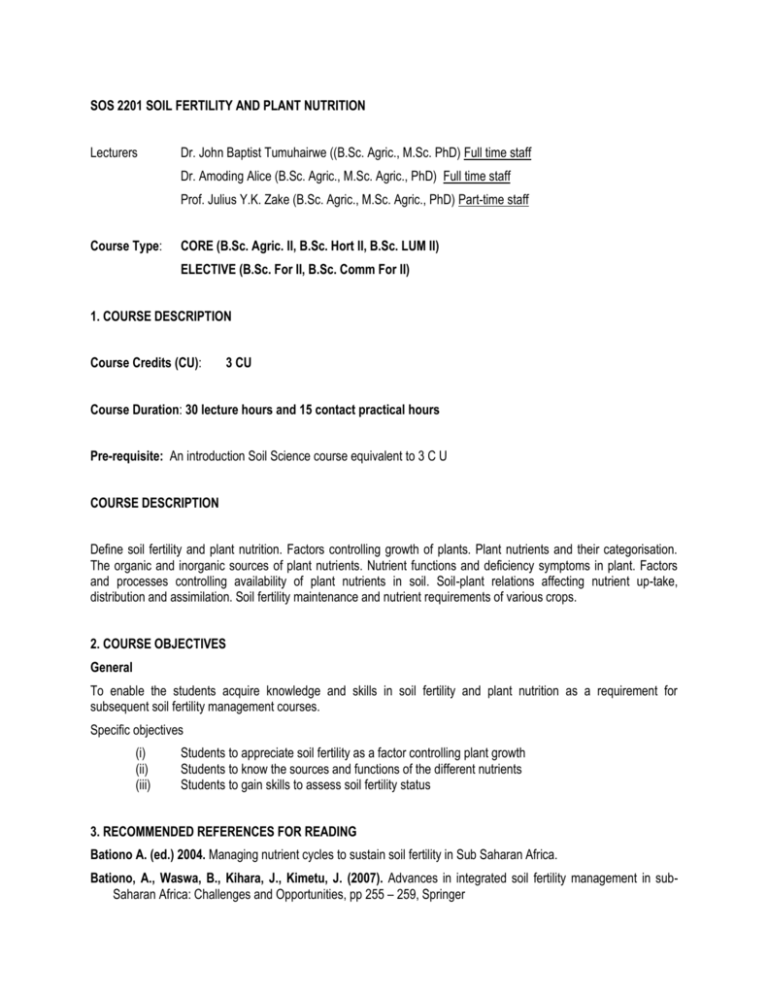SOS 2201 SOIL FERTILITY AND PLANT NUTRITION
advertisement

SOS 2201 SOIL FERTILITY AND PLANT NUTRITION Lecturers Dr. John Baptist Tumuhairwe ((B.Sc. Agric., M.Sc. PhD) Full time staff Dr. Amoding Alice (B.Sc. Agric., M.Sc. Agric., PhD) Full time staff Prof. Julius Y.K. Zake (B.Sc. Agric., M.Sc. Agric., PhD) Part-time staff Course Type: CORE (B.Sc. Agric. II, B.Sc. Hort II, B.Sc. LUM II) ELECTIVE (B.Sc. For II, B.Sc. Comm For II) 1. COURSE DESCRIPTION Course Credits (CU): 3 CU Course Duration: 30 lecture hours and 15 contact practical hours Pre-requisite: An introduction Soil Science course equivalent to 3 C U COURSE DESCRIPTION Define soil fertility and plant nutrition. Factors controlling growth of plants. Plant nutrients and their categorisation. The organic and inorganic sources of plant nutrients. Nutrient functions and deficiency symptoms in plant. Factors and processes controlling availability of plant nutrients in soil. Soil-plant relations affecting nutrient up-take, distribution and assimilation. Soil fertility maintenance and nutrient requirements of various crops. 2. COURSE OBJECTIVES General To enable the students acquire knowledge and skills in soil fertility and plant nutrition as a requirement for subsequent soil fertility management courses. Specific objectives (i) (ii) (iii) Students to appreciate soil fertility as a factor controlling plant growth Students to know the sources and functions of the different nutrients Students to gain skills to assess soil fertility status 3. RECOMMENDED REFERENCES FOR READING Bationo A. (ed.) 2004. Managing nutrient cycles to sustain soil fertility in Sub Saharan Africa. Bationo, A., Waswa, B., Kihara, J., Kimetu, J. (2007). Advances in integrated soil fertility management in subSaharan Africa: Challenges and Opportunities, pp 255 – 259, Springer Ebanyat, P. (2009). A road to food? Efficacy of nutrient management options targeted to heterogeneous soilscapes in Teso farming systems, Uganda. A PhD Thesis, Wageningen University. Gichuru, M.P., Bationo, A., Bekunda, M.A., Goma, H.C., Mafongoya, P.L., Mugendi, D.N., Murwira, H.K., Nandwa, S.M., Nyathi, P., Swift, M.J. (eds.) 2003. Soil fertility management in Africa: A regional perspective. Nkonya, E., Kaizzi, C., Pader, J., (2005). Determinants of nutrient balances in eastern Uganda. Agricultural systems 85: 155 – 182. Prasad, R., Power, J.F. (1997). Soil fertility management for sustainable agriculture. Lewis Publishers, New York. Sundberg C., 2005. Improving Compost Process Efficiency by controlling Aeration, Temperature and pH. A Doctoral Thesis Tidsale S.L., Werner N.L., Beaton J.D., Havlin J.L. 1993. Soil fertility and fertilizer; 5th Edition, Chapters 1 – 10, 12 and 13. 4. COURSE CONTENT, METHODS OF INSTRUCTION, TOOLS AND EQUIPMENT REQUIRED TOPIC CONTENT Definitions of soil fertility, productivity and plant nutrients History and status of soil fertility in the world with emphasis to Uganda Factors affecting plant growth Plant nutrients Plant nutrients: forms as taken up by plants Functions and classification based on deficiency/toxicity amount required by indicators plants functions to plants deficiency and toxicity indicators Toxic elements to plants available in soil and the condition that lead to their uptake INTRODUCTION Sources of plant Nutrients METHOD OF TOOLS / EQUIPMENT INSTRUCTION / NEEDED Time allocated Interactive (2 hours) lectures Chalk / BB or Markers / Flip charts Interactive (5 hours) lectures Chalk / BB or Markers / Flip charts Field trip to assess Computer and project nutrient deficiency/toxicity on Transport and practical plants (1.5 hours) handbook Practical: determination of N in Plant samples, reagents plant tissues (1.5 for N analysis, laboratory space hours Nutrient added in an agricultural Interactive lectures Chalk / BB or Markers / system (2 hours) Flip charts Organic Vs inorganic sources of Practical: plant nutrients Determination of N Soil samples, reagents for in soil (1.5 hours) available P and CEC Determination of determination, laboratory available P (1.5 space hours) Determination of cation exchange capacity (1.5 hours) Nutrient lost from agricultural Interactive system (4 hours) How to minimize loss for each nutrient Factors controlling availability of nutrients in soil Nutrient concentrations in soil and ground water in relation to environmental concerns Nutrient management in soil Nutrient plants uptake by Mechanisms of nutrient uptake lectures Chalk / BB or Markers / Flip charts Interactive (3 hours) lectures Chalk / BB or Markers / Flip charts Cycles of major plant nutrients Interactive (carbon, nitrogen, phosphorus, (2 hours) potassium, sulphur, calcium and magnesium lectures Chalk / BB or Markers / Flip charts o Diffusion o Osmosis Factors affecting uptake of nutrients by plants Nutrient cycles Essential nutrient for different plants Soil organic matter as a sink for soil fertility in Sub Saharan Africa Plant nutrient requirements for each Lecture (4 hours) crop with special emphasis to major crops grown in Uganda (e.g. banana, maize, millet, beans, groundnuts, cassava, coffee, cotton Soil organic matter o o o o o o Factors controlling soil fertility Sources of soil organic matter to soil Status of organic matter in soil with special emphasis to Uganda Nature and composition Effect on soil properties Effect of nutrient supply C:N ratio as a factor in soil organic matter mineralization and nutrient release Interactive (2 hours) lectures Chalk / BB or Markers / Flip charts Practical Soil samples and Determination of soil reagents for organic organic matter (wet carbon determination method) (1.5 hours) Interactive (2 hrs) lectures Chalk / BB or Markers / Flip charts Practical on soil pH in water (1.5 hours) Processes controlling soil fertility Interactive (2 hrs) lectures Chalk / BB or Markers / Flip charts Liming practical (1.5 hours) Composting o o o o Composting process Why compost? Factors that affect the process (e.g. C:N ratio, temperature, aeration, microorganisms, pH and moisture content) How would you tell mature/ ready compost? Composting in practice Procedure Materials monitoring 5. SUMMARY OF TIME NEEDED Interactive lectures covering theory 30 hrs Laboratory and field-based practicals 15 hrs 6. OVERALL COURSE EVALUATION Three continuous assessment 20 Six practical reports 20 Final examination 60 Total 100 Interactive Lectures Chalk / BB or Markers / (3 hr) Flip charts Practical (3 hr)







